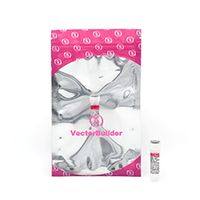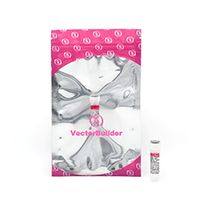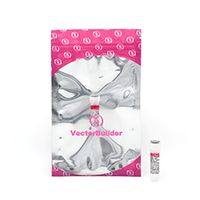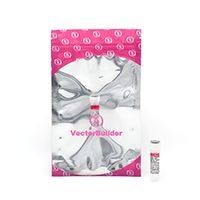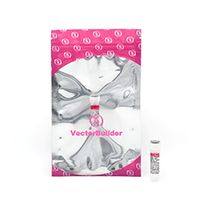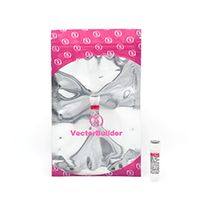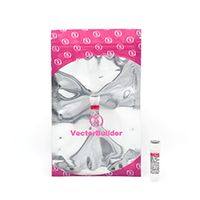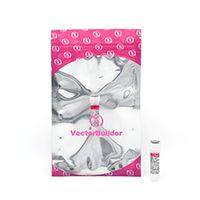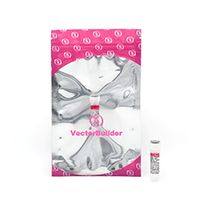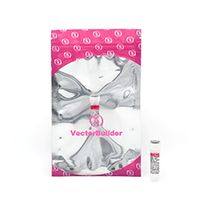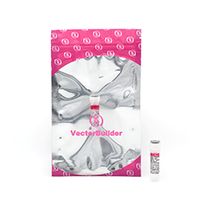
产品详情
文献和实验
相关推荐
提供商 :云舟生物科技(广州)股份有限公司
服务名称 :定制载体
此价格为VectorBuilder该类型产品标准服务价格,如需个性化定制,请询价。概述
基于腺病毒miR30的shRNA敲低载体系统是一种高效的病毒载体,用于敲低多种哺乳动物细胞类型中靶基因的表达。它利用腺病毒介导的多顺反子表达盒的递送,该盒由一个或多个基于miR30的shRNA(shRNAmiR)靶向感兴趣的基因和用户选择的ORF组成,其中载体保留为游离体DNA,而不整合到宿主基因组中。shRNAmiR转录本由内源性细胞微RNA途径处理以产生成熟的shRNA,从而促进靶基因mRNA的降解。它是体内首要选的基因敲低系统,常用于基因治疗和疫苗接种。
首先在大肠杆菌中构建基于腺病毒miR30的shRNA载体作为质粒。在两个倒置末端重复序列(ITR)之间克隆由一个或多个靶向目标基因的shRNAmiR和用户选择的ORF组成的多顺反子表达盒。然后将其转染到包装细胞中,其中ITR之间的载体区域被包装成活病毒。当病毒被添加到靶细胞中时,DNA货物被传递到细胞中,在那里它进入细胞核并保持为游离体DNA,而不整合到宿主基因组中。在载体构建过程中放置在两个ITR之间的任何基因都与病毒基因组的其余部分一起引入靶细胞。
与利用RNA聚合酶III启动子(如U6)的传统shRNA载体不同,基于miRNA的shRNA系统置于标准RNA聚合酶II启动子的控制之下。这允许使用组织特异性、诱导性或可变强度启动子,从而实现组成型 U6 启动子无法实现的各种实验应用。
相对于其他敲低载体系统,RNA聚合酶II启动子在基于miRNA的shRNA系统中有效转录长转录本的能力也提供了额外的优势。多个shRNAmiR可以转录为单个多顺子,其被加工成细胞内成熟的shRNA。这允许使用单个转录本敲低多个基因或靶向同一基因内的多个区域。因此,该载体可用于表达单个或多个shRNAmiR。其次,在该载体系统中,用户选择的蛋白质编码基因也位于与shRNAmiR相同的多顺子中。该ORF的表达可用于直接监测shRNA转录(如果使用标记ORF),或可用于需要ORF和shRNA共表达的其他目的。
根据设计,腺病毒载体缺乏E1A,E1B和E3基因(delta E1 + delta E3)。前两个是生产活病毒所必需的(这两个基因被设计到包装细胞的基因组中)。因此,由载体产生的病毒具有复制不全的重要安全特征(这意味着它们可以转导靶细胞但不能在其中复制)。
多个 shRNA 共表达: 由于RNA聚合酶II有效地转录长RNA,因此多个shRNAmiR可以表达为来自单个启动子的多顺子。因此,该载体可用于表达单个或多个shRNAmiR。
记者ORF的共同表达: 用户选择的目的基因或报告基因ORF与shRNAmiR共表达,作为多顺子。这有助于直接监测shRNA转录。
宿主基因组破坏风险低:转导到宿主细胞后,腺病毒载体在细胞核中保留为游离体DNA。缺乏与宿主基因组的整合可能是体内人类应用的理想特征,因为它降低了可能导致癌症的宿主基因组破坏的风险。
非常高的病毒滴度: 在我们的腺病毒载体被转染到包装细胞中以产生活病毒后,病毒可以通过重新感染包装细胞进一步扩增到非常高的滴度。这与慢病毒、MMLV 逆转录病毒或 AAV 不同,后者不能通过再感染扩增。当通过我们的病毒包装服务获得腺病毒时,滴度可以达到>1011每毫升感染单位(IFU/毫升)。
广义向性: 来自常用哺乳动物物种(如人类,小鼠和大鼠)的细胞可以用我们的载体转导,但某些细胞类型已被证明难以转导(见下面的缺点)。
体外和体内有效性: 我们的载体通常用于转导活体动物的细胞,但它也可以在体外有效使用。
安全:我们的载体的安全性是由它缺乏病毒生产所必需的基因(这些基因被工程到包装细胞的基因组中)这一事实来保证的。因此,由我们的载体制成的病毒是复制能力不全的,除非它用于转导包装细胞。
难以转导某些细胞类型:虽然我们的腺病毒载体可以转导许多不同的细胞类型,包括非分裂细胞,但它对某些细胞类型(如内皮细胞、平滑肌、分化气道上皮、外周血细胞、神经元和造血细胞)效率低下。
免疫原性强:来自腺病毒载体的活病毒可以在动物中引起强烈的免疫反应,从而限制了某些体内应用。
技术复杂性: 腺病毒载体的使用需要在包装细胞中产生活病毒,然后测量病毒滴度。这些程序在技术上要求很高且耗时。
单个 miR30-shRNA 腺病毒 shRNA 敲低载体
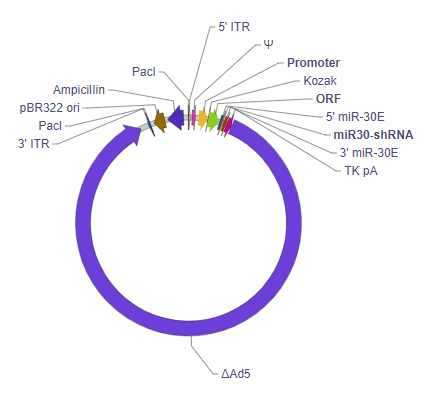
5' ITR: 5' inverted terminal repeat. In wild type virus, 5' ITR and 3' ITR are essentially identical in sequence. They reside on two ends of the viral genome pointing in opposite directions, where they serve as the origin of viral genome replication.
Ψ: Adenovirus packaging signal required for the packaging of viral DNA into virus.
Promoter: Drives transcription of the downstream ORF and shRNAmiR polycistron. This is an RNA polymerase II promoter, rather than an RNA polymerase III promoter such as U6.
Kozak: Kozak consensus sequence. It is placed in front of the start codon of the ORF of interest because it is believed to facilitate translation initiation in eukaryotes.
ORF: The open reading frame of your gene of interest or reporter gene is placed here. This can be used to monitor shRNA expression.
5' miR-30E: An optimized version of the human miR30 5’ context sequence. Facilitates maturation and processing of the shRNA and separation from the tandemly transcribed ORF and other shRNAs.
3' miR-30E: An optimized version of the human miR30 3’ context sequence. Facilitates maturation and processing of the shRNA and separation from the tandemly transcribed ORF and other shRNAs.
miR30-shRNA: This sequence is derived from your target sequence and is transcribed to form the stem portion of the “hairpin” structure of the shRNA.
TK pA: Herpes simplex virus thymidine kinase polyadenylation signal. Facilitates transcription termination and polyadenylation of the upstream ORF and shRNAmiR polycistron.
ΔAd5: Portion of Ad5 genome between the two ITRs minus the E1A, E1B and E3 regions.
3' ITR: 3' inverted terminal repeat.
pBR322 ori: pBR322 origin of replication. Plasmids carrying this origin exist in medium copy numbers in E. coli.
Ampicillin: Ampicillin resistance gene. It allows the plasmid to be maintained by ampicillin selection in E. coli.
PacI: PacI restriction site (PacI is a rare cutter that cuts at TTAATTAA). The two PacI restriction sites on the vector can be used to linearize the vector and remove the vector backbone from the viral sequence, which is necessary for efficient packaging.
Multiple miR30-shRNA adenovirus shRNA knockdown vector
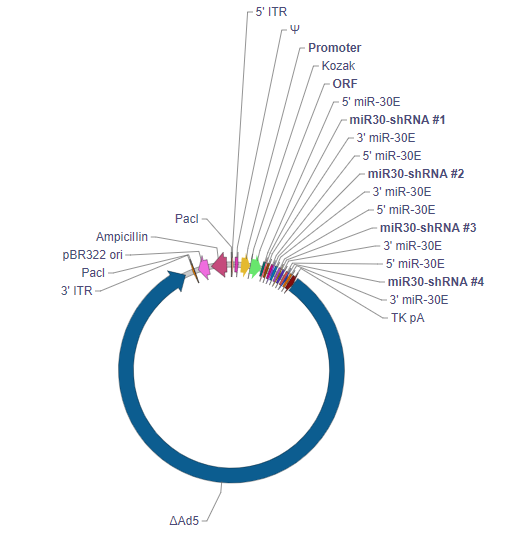
5' ITR: 5' inverted terminal repeat. In wild type virus, 5' ITR and 3' ITR are essentially identical in sequence. They reside on two ends of the viral genome pointing in opposite directions, where they serve as the origin of viral genome replication.
Ψ: Adenovirus packaging signal required for the packaging of viral DNA into virus.
Promoter: Drives transcription of the downstream ORF and shRNAmiR polycistron. This is an RNA polymerase II promoter, rather than an RNA polymerase III promoter such as U6.
Kozak: Kozak consensus sequence. It is placed in front of the start codon of the ORF of interest because it is believed to facilitate translation initiation in eukaryotes.
ORF: The open reading frame of your gene of interest or reporter gene is placed here. This can be used to monitor shRNA expression.
5' miR-30E: An optimized version of the human miR30 5’ context sequence. Facilitates maturation and processing of the shRNA and separation from the tandemly transcribed ORF and other shRNAs.
3' miR-30E: An optimized version of the human miR30 3’ context sequence. Facilitates maturation and processing of the shRNA and separation from the tandemly transcribed ORF and other shRNAs.
miR30-shRNA #1: This sequence is derived from your first target sequence and is transcribed to form the stem portion of the “hairpin” structure of the shRNA.
miR30-shRNA #2: This sequence is derived from your second target sequence and is transcribed to form the stem portion of the “hairpin” structure of the shRNA.
miR30-shRNA #3: This sequence is derived from your third target sequence and is transcribed to form the stem portion of the “hairpin” structure of the shRNA.
miR30-shRNA #4: This sequence is derived from your fourth target sequence and is transcribed to form the stem portion of the “hairpin” structure of the shRNA.
TK pA: Herpes simplex virus thymidine kinase polyadenylation signal. Facilitates transcription termination and polyadenylation of the upstream ORF and shRNAmiR polycistron.
ΔAd5: Portion of Ad5 genome between the two ITRs minus the E1A, E1B and E3 regions.
3' ITR: 3' inverted terminal repeat.
pBR322 ori: pBR322 origin of replication. Plasmids carrying this origin exist in medium copy numbers in E. coli.
Ampicillin: Ampicillin resistance gene. It allows the plasmid to be maintained by ampicillin selection in E. coli.
PacI: PacI restriction site (PacI is a rare cutter that cuts at TTAATTAA). The two PacI restriction sites on the vector can be used to linearize the vector and remove the vector backbone from the viral sequence, which is necessary for efficient packaging.

云舟生物科技(广州)股份有限公司
品牌商实名认证
金牌会员
入驻年限:6年

